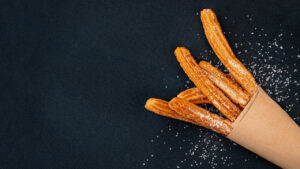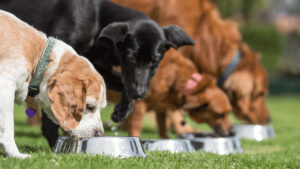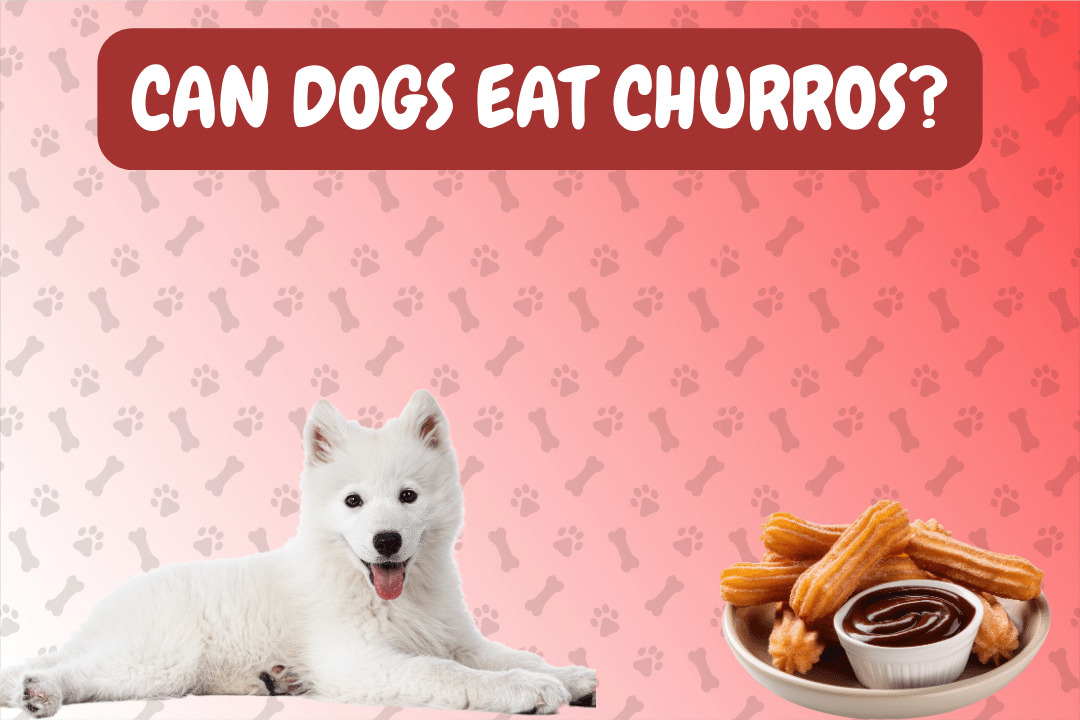No, dogs can’t eat churros, because they are high in sugar, fat, and calories, and can cause serious health problems for your canine companion.
Table of Contents
Introduction
Churros are a popular snack or dessert that originated in Spain and Portugal, and are now enjoyed all over the world. They are made of fried dough that is coated with sugar and cinnamon, and sometimes dipped in chocolate or other sauces. They are crispy on the outside and soft on the inside, and have a sweet and spicy flavor.
But while churros may be a delicious treat for humans, the question is can dogs eat churros. In fact, feeding churros to your dog can be very harmful and even dangerous. In this article, we will explain can dogs eat churros, also what are the potential risks of giving them to your dog, and how to serve them safely if you must. Also we will read about what are some alternative treats you can offer your dog instead, and what to do if accidentally your dogs eat churro.
Nutritional Value
Churros have very little nutritional value for dogs. They are mostly made of refined flour, which is a source of simple carbohydrates that can spike your dog’s blood sugar levels and lead to obesity and diabetes. They also contain a lot of oil, which adds fat and calories to your dog’s diet and can cause pancreatitis, a painful inflammation of the pancreas that can be life-threatening. Moreover, churros are loaded with sugar and cinnamon, which can cause dental problems, digestive upset, and allergic reactions in some dogs.
According to the USDA, one medium-sized churro (about 57 grams) has about 229 calories, 11 grams of fat (of which 2 grams are saturated), 29 grams of carbohydrates (of which 10 grams are sugars), 3 grams of protein, and 0.4 grams of fiber. It also has 149 milligrams of sodium, which is too much for dogs and can cause dehydration and high blood pressure.
As you can see, churros are not a healthy snack for dogs, and should be avoided at all costs.

Potential Risks
Feeding churros to your dog can pose several risks to their health and well-being. Some of the possible consequences of giving churros to your dog are:
- 1. Obesity: Churros are high in calories and fat, which can make your dog gain weight quickly and become obese. Obesity can lead to many health problems for dogs, such as arthritis, heart disease, respiratory issues, liver disease, kidney disease, and cancer.
- 2. Diabetes: Churros are high in sugar and simple carbohydrates, which can raise your dog’s blood glucose levels and cause insulin resistance. This can result in diabetes mellitus, a chronic condition that requires lifelong management and medication.
- 3. Pancreatitis: Churros are high in fat, which can overload your dog’s pancreas and cause it to become inflamed. Pancreatitis is a serious condition that can cause vomiting, diarrhea, abdominal pain, fever, dehydration, shock, and even death.
- 4. Dental Problems: Churros are sticky and sugary, which can adhere to your dog’s teeth and gums and cause plaque buildup, tartar formation, tooth decay, gum disease, bad breath, and tooth loss.
- 5. Digestive Upset: Churros are rich in oil and spices, which can irritate your dog’s stomach and intestines and cause nausea, vomiting, diarrhea, gas, bloating, cramps, and loss of appetite.
- 6. Allergic Reactions: Churros contain cinnamon, which is a common allergen for some dogs. Cinnamon can cause itching, hives, swelling, redness, sneezing, coughing, wheezing, difficulty breathing, anaphylaxis, and shock in dogs that are allergic to it.
As you can see, churros are not worth the risk for your dog, and can cause a lot of harm and discomfort to them.
How to Serve Safely Churros to Dogs
The best way to serve safely churros to dogs is not to serve them at all. Churros are not meant for dogs, and there is no safe amount or way to give them to your canine friend. Even a small bite of a churro can be harmful to your dog, and can trigger any of the potential risks mentioned above.
If you really want to share a churro with your dog, you should consult your veterinarian first, and follow their advice. They may tell you to avoid churros altogether, or to give your dog a very small piece of a plain churro without any sugar, cinnamon, or sauce, and only as an occasional treat.
They may also tell you to monitor your dog for any signs of distress or adverse reactions after giving them a churro, and to seek immediate veterinary attention if you notice anything wrong.
However, even with your veterinarian’s approval, you should be very careful and cautious when giving churros to your dog, and always keep in mind the potential risks and consequences.
Serving Suggestions
If you love churros, and want to enjoy them without harming your dog, there are some things you can do:
- 1. Keep churros out of your dog’s reach: Store churros in a sealed container, and keep them in a high shelf or cabinet, where your dog can’t access them. Never leave churros unattended on the table, counter, or floor, where your dog can snatch them. If you are eating churros outside, make sure your dog is on a leash, and don’t let them approach any stalls or vendors that sell churros.
- 2. Don’t feed churros to your dog: Resist the temptation to give churros to your dog, no matter how much they beg or look at you with their puppy eyes. Remember that churros are not good for dogs, and can cause serious health problems for them. Instead of giving churros to your dog, offer them a healthy and safe treat that is suitable for their species and diet.
- 3. Find alternative treats for your dog: There are many other treats that you can give to your dog instead of churros, that are nutritious and delicious for them. For example, you can give your dog some fresh fruits or vegetables, such as apples, bananas, carrots, cucumbers, or blueberries. You can also give your dog some low-fat plain yogurt, peanut butter, cheese, or eggs. Make sure to avoid any foods that are toxic or harmful for dogs, such as chocolate, grapes, raisins, onions, garlic, macadamia nuts, xylitol, or alcohol. Always check the ingredients list of any treat you give to your dog, and consult your veterinarian if you are unsure.

Special Considerations
Some dogs may have special considerations that make churros even more dangerous for them. For example:
- 1. Dogs with diabetes: Dogs with diabetes need to follow a strict diet that is low in sugar and carbohydrates, and high in protein and fiber. Churros are the opposite of what diabetic dogs need, and can cause severe complications for them. Diabetic dogs should never eat churros, or any other sugary or starchy foods.
- 2. Dogs with pancreatitis: Dogs with pancreatitis need to follow a low-fat diet that is easy to digest and does not strain their pancreas. Churros are high in fat and oil, and can aggravate the inflammation and pain of pancreatitis. Dogs with pancreatitis should never eat churros, or any other fatty or greasy foods.
- 3. Dogs with allergies: Dogs with allergies need to avoid any foods that they are allergic or sensitive to. Churros contain cinnamon, which is a common allergen for some dogs. Dogs with allergies should never eat churros, or any other foods that contain their allergens.
If your dog has any of these conditions, or any other medical issues, you should consult your veterinarian before giving them any treats, and follow their recommendations.
Expert Opinion
Most veterinarians and experts agree that churros are not good for dogs, and advise against feeding them to your canine companion. Here are some quotes from some reputable sources:
“Churros are not healthy for dogs. They are high in calories, fat, sugar, and sodium, and can cause obesity, diabetes, pancreatitis, dental problems, digestive upset, and allergic reactions. They have no nutritional value for dogs, and should be avoided at all costs.” – Dr. Jennifer Coates, DVM
“Churros are one of the worst treats you can give to your dog. They are loaded with sugar and fat, which can lead to serious health issues for your dog. They can also cause choking hazards if they are too large or hard for your dog to swallow. Churros are not worth the risk for your dog, and should be replaced with healthier alternatives.” – Dr. Marty Becker, DVM
“Churros are a no-no for dogs. They are too sweet and too fatty for dogs, and can cause a lot of problems for them. Also they can cause weight gain, diabetes, pancreatitis, dental disease, allergies, and more. They have nothing to do with dogs’ natural diet, and should be completely avoided.” – Dr. Karen Becker, DVM
Conclusion
To conclude, dogs can’t eat churros, because they are high in sugar, fat, and calories, and can cause serious health problems for your canine companion. Churros have no nutritional value for dogs, and can cause obesity, diabetes, pancreatitis, dental problems, digestive upset, and allergic reactions. There is no safe amount or way to give churros to your dog, and you should always keep them out of your dog’s reach. Instead of giving churros to your dog, you should offer them healthy and safe treats that are suitable for their species and diet. If your dog accidentally eats a churro, you should contact your veterinarian immediately, and follow their instructions.
FAQ about Can Dogs Eat Churros
1. Can I give my dog a small piece of a churro as a treat?
No, it’s not recommended to give your dog any amount of churro as a treat. Churros are high in sugar, fat, and calories, which can be harmful to your dog’s health.
2. What are the potential risks of feeding churros to my dog?
Feeding churros to your dog can lead to obesity, diabetes, pancreatitis, dental problems, digestive upset, and allergic reactions. These health issues can be serious and may require veterinary care.
3. Are plain churros without sugar and cinnamon safe for dogs?
Plain churros without sugar and cinnamon are still high in fat and can cause digestive issues and pancreatitis in dogs. It’s best to avoid giving them to your dog entirely.
4. What should I do if my dog accidentally eats a churro?
If your dog consumes a churro, contact your veterinarian immediately. They can assess the situation and provide guidance on how to proceed, as it may depend on the amount ingested and your dog’s size.
5. Can churros cause allergies in dogs?
Churros containing cinnamon can trigger allergies in some dogs. Allergic reactions may include itching, hives, swelling, and difficulty breathing. It’s safer to keep churros away from dogs with known allergies.
6. Are there any safer alternatives to churros for dogs?
Yes, there are many safe and healthier treats for dogs. You can offer your dog fresh fruits like apples and bananas, vegetables like carrots, or dog-safe commercial treats available in pet stores.
7. Can churros lead to weight gain in dogs?
Yes, churros are calorie-dense and high in fat. Regular consumption can lead to weight gain, which in turn increases the risk of various health issues in dogs, including obesity.
8. Why are churros not suitable for diabetic dogs?
Churros are rich in sugar and simple carbohydrates, which can raise blood glucose levels. For diabetic dogs, it’s crucial to maintain stable blood sugar levels, making churros a poor choice due to their potential to exacerbate the condition.
9. Can I give my dog a small piece of a churro on special occasions?
While it’s tempting to share special treats with your dog, churros should not be one of them. Even a small piece can have adverse health effects, so it’s best to choose a dog-friendly alternative for special occasions.
10. What are the signs of digestive upset in dogs after consuming churros?
Digestive upset in dogs may manifest as nausea, vomiting, diarrhea, gas, bloating, cramps, and loss of appetite. If you suspect your dog has eaten a churro and shows these symptoms, consult your veterinarian promptly.
For more food informations about Dogs, keep reading our blog. We add daily 2 to 3 articles about pets food.
Hello! I’m Max Walley, a pet enthusiast who knows a lot about what our animal buddies can munch on and what’s a no-no. With ‘canpeteat.it,’ I’m here to help pet owners make smart food choices. Come with me as we dive into the world of pet nutrition, discovering what keeps our furry pals joyful and in tip-top shape. Let’s explore this adventure together!


